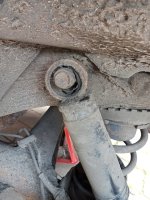Both the rear bump stops on my 100hp Panda have become detached and are making a racket banging around inside the springs.
Is it possible to buy some better shocks that won't have the bump stops fall off after a couple of years? Surely not all shocks will have such bad design?
If better shocks aren't available I'll try to fit a central bolt to fix them into place although I realise that rust may prevent this.
I'm guessing that removing the shocks isn't too bad a job.
Is it possible to buy some better shocks that won't have the bump stops fall off after a couple of years? Surely not all shocks will have such bad design?
If better shocks aren't available I'll try to fit a central bolt to fix them into place although I realise that rust may prevent this.
I'm guessing that removing the shocks isn't too bad a job.


